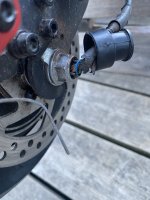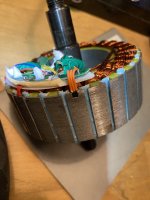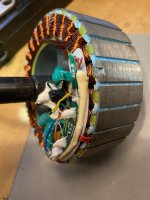Hi Amberwolf,
Firstly: about the first part of your answer, regarding motor spinning in reverse: SO this is not an issue right, i dont have to do anything about what i experience here?
It's an issue in that it wont drive the wheel while running in reverse. If this persists, then to fix it you'd need to either run the self-learn function of the controller, or use it's reverse function, or if it has neither of those you'd have to manually try the different phase/hall wiring combinations while testing current as I previously noted.
Regarding hall: I have tested with controller connected and turned on. I got fine 0 and 5V readings on two of the halls when manually spinning the wheel slowly in reverse. (measuring from gnd to hall pins on/in the connector).
If the third hall doesn't do the same thing the other two do, it's usually a wiring fault rather than a hall failure--any break in the wire from hall signal to controller prevents getting the pullup voltage to the hall or the hall signal to the controller to be able to test it.
If the hall itself doesn't work, it can be replaced with pretty much any SS41 / SS411 type of bipolar latching open collector output sensor that can run on up to 5v+ and tolerate 5v+ on the open-collector signal line.
Any hall that actually outputs a voltage isn't appropriate, it needs to ground it's output (open collector) when active, and open-circuit the output when inactive, so the controller pullup on the signal line does the job it needs to.
It *might* still work with a hall that outputs 5v when inactive and grounds when active, but the pullup inside the controller may interfere with this operation.
It has to be bipolar, so it detects both north and south magnets.
Needs to be latching so it holds it's output from one magnet pass until the next one comes by to switch it again.
Note that there are some hall sensors where the same part number (like 41) has several subsets of features, so that say, F might mean bipolar latching but G means unipolar nonlatching, etc. So before you order make sure you know what the full p/n is that you need from the datasheet. (it can be confusing).
The controller usually outputs less than 5v on hall power, so it may have to be able to operate reliably on less than 5v, but should be tolerant of voltages higher than that.
The pullup voltage in the controller on the signal line is usually 5v, so the signal pin has to be tolerant of at least this voltage or higher (noise spikes can be induced on the signal wires in the motor cable, so higher voltage tolerance on this pin is sometimes useful).
I would guess that the SS413A is a closer match than the 466, but the specs listed there are not complete on all of each listing so I'm not certain. It doesn't say it is latching, but the 466 does, but the 466 doesn't say it's bipolar while the 413 does. The 466 will run on a lower supply voltage so it could be more tolerant of brownouts on the 5v supply line from the controller, but there's no spec on the 413 listing for that.
So...I'm not sure which of those two is a better option.







